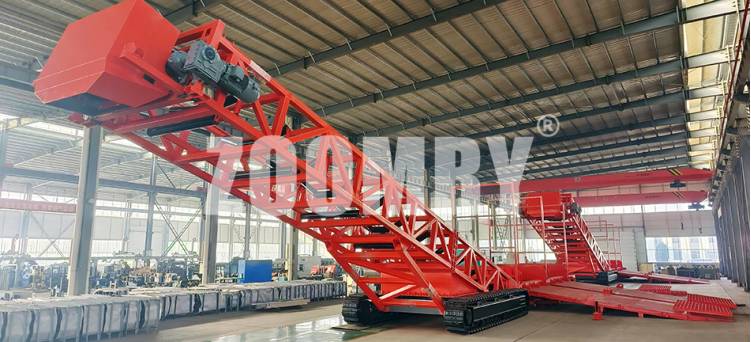According to the International Energy Agency's (IEA) recent Industrial Energy Efficiency Report, material handling equipment accounts for approximately 12% of global industrial electricity consumption, with bulk material handling systems representing over 35% of this share. Notably, World Steel Association statistics indicate that transporting one ton of iron ore from mine to smelter generates an average of 8.5kg CO₂ emissions, with truck unloaders - as the first link in bulk material transfer - exerting a leverage effect on the entire supply chain's carbon footprint.
With growing global emphasis on energy conservation, this issue has evolved from technical optimization to strategic priority. Global Market Insights projects the bulk material handling equipment market to exceed $32 billion by 2030, with a 4.7% CAGR, yet concurrent energy consumption pressures demand urgent solutions. Driven by both the EU Carbon Border Adjustment Mechanism (CBAM) and ISO 50001 Energy Management Systems, reducing equipment energy consumption through technological innovation and scientific management has become a shared focus for manufacturers and end-users alike. As a specialized equipment manufacturer with 20+ years in bulk material handling, ZOOMRY leverages data from 132 global projects across six continents to deliver proven energy-saving solutions spanning power system optimization, structural innovation, and intelligent control technologies.

Power System Optimization
Truck unloader energy consumption primarily stems from hydraulic drives, conveyor operation, and mobility systems. Breakthrough efficiency gains can be achieved through:
Hydraulic System Upgrade
Traditional systems suffer low energy conversion (60-70%) and high overflow losses. ZOOMRY's ZRLS-TU series implements load-sensing hydraulics with pressure-compensating valves that reduce consumption by 18-25%. Automatic standby mode activation during idle periods minimizes no-load power draw.
Variable Frequency Drive (VFD) Technology
ABB/Siemens intelligent drives dynamically adjust motor speed based on material flow. Field tests show 30%+ energy savings at 70% rated flow capacity.
Power Matching Strategy
Precise powertrain configuration for material characteristics:
- Coal (0.8-1.0t/m³): 4-pole motors + planetary gearboxes
- Iron ore (2.5t/m³): 6-pole motors + hardened gear reducers
Eliminates "oversized motor" energy waste.
Structural Optimization
Low-Resistance Conveyor Belting
Steel-cable core belts reduce friction by 40% versus traditional fabric belts, with 30° troughing idlers cutting no-load power 15%.
Lightweight Materials
HSLA high-strength steel frames maintain structural integrity while reducing weight 18%. Aluminum honeycomb track plates offer 30% weight savings over cast steel.
Modular Quick-Disconnect
ISO 6162 hydraulic flanges cut maintenance downtime 70%. FLEXCO Bolt Hinged belt splices enable 5x faster installation, reducing energy losses from extended outages.
Intelligent Control Systems
IoT and AI integration unlocks new efficiency frontiers:
Automated Dispatch
GPS/RFID monitoring optimizes truck queue sequencing, slashing idle time from 2.1 to 0.3 hours daily.
Energy Monitoring Platform
Power quality analyzers capture voltage, current, and PF data at 1-second intervals. Heat mapping identifies peak consumption periods.
Predictive Maintenance
Vibration sensors and thermal imaging provide 3-6 month advance warning of bearing wear or belt misalignment. Preventive strategies achieve 92% OEE by avoiding breakdown-related waste.
Operational & Maintenance Management
30% of energy anomalies stem from operational errors or maintenance gaps. ZOOMRY recommends:
Standard Operating Procedures (SOP)
Develop the Energy-Saving Operation Manual for Truck Unloaders, standardizing key parameters including hopper fill rate (recommended 70%-90%) and conveyor pre-start duration (not exceeding 5 minutes). Certified operators after training can reduce energy consumption variability by 40%.
Tiered Maintenance Plan
Three-level "Daily-Weekly-Monthly" system:
- Daily: Hydraulic oil temp (40-60°C), belt tension (1-2% sag)
- Weekly: Cooler fin cleaning (85%+ heat transfer efficiency)
- Monthly: Motor insulation (≥100MΩ), gear oil cleanliness (NAS 7)
Maintains ±5% efficiency stability while extending component life 30%.
Lubricant Upgrade
Synthetic oils reduce friction 25%, lowering operating temps 8-12°C for 7% annual energy savings.
System Integration Solutions
Shifting from unit-level to system-wide optimization:
Multi-Equipment Coordination
Intelligently network truck unloaders with telescopic stackers, mobile shiploaders, and pipe belt conveyors. When stockyard material level reaches 80%, the system automatically reduces unloader speed to prevent downstream equipment idling.
Waste Heat Recovery
Hydraulic oil heat exchangers (65→45°C) provide winter preheating or office heating, saving $32k/year.
ZOOMRY's integrated approach delivers 22-35% energy reductions in global projects. At one copper mine, five ZRLD-TU1800 units saved 87,000L diesel annually (230t CO₂ reduction). For technical specifications or project solutions, contact:
| ZOOMRY Product Center | Email: oversea@zoomry.cn | Tel/WhatsApp: +86 131-6401-6717 |

 ZOOMRY
ZOOMRY

